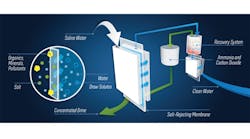Fracking wastewater is one of the top environmental concerns the oil and gas industry faces amid the shale gas revolution.
Addressing the issue through new technologies could lessen public fears and create another growing industry.
The frack water treatment industry is expected to grow 28% annually by 2020 to $9 billion, Lux Research reported in May.
Many established companies, such as General Electric Co. (IW 500/5), and startups are introducing new technologies to handle fracking wastewater.
Fracking requires between 25,000 and 140,000 barrels of water per well and produces toxin‐laced brine that can be more than six times as salty as the sea, Lux Research reported in the May study. The storage and disposal of this salty solution has attracted the attention of politicians, environmentalists and citizen groups.
Earlier in the year, earthquakes near fracking wastewater injection wells in Youngstown, Ohio, prompted the state to shut down all wells within a five mile radius of the site. Ohio has been examining new technologies that can help clean fracking water, Gov. John Kasich said in May at an energy conference.
Moving Forward With Osmosis
One of the newer growing technologies to treat frack water is called forward osmosis. A venture-backed company formed in 2009 called Oasys Water Inc. developed the technology with researchers from Yale University.
The technology was initially developed for desalinating seawater. Current desalinating technologies require a significant amount of hydraulic pressure to force saltwater through a membrane that filters the water.
The system developed by Boston- based Oasys applies a solution that pulls freshwater molecules across the membrane and leaves behind all contaminants,says Lisa Sorgini Marchewka, vice president of strategy and marketing development at Oasys. The solution is then heated at a low temperature and turned into vapor, leaving only fresh water.
The advantage over reverse osmosis is the ability to use less energy-intensive heating sources and a proprietary membrane that can tolerate higher salinity levels, says Oasys CEO Jim Matheson.
The technology, which Oasys calls Engineered Osmosis, is approximately 50% less costly than traditional methods, Sorgini Marchewka says.
The forward osmosis method is gaining traction throughout the water treatment industry, Sorgini Marchewka says.
In March, the company announced a partnership with Select Energy Services LLC, a Houston company that provides water services to the oil and natural gas industry. Select Energy will use the system in the oil-rich Permian Basin.
The company also is moving into the Marcellus and Bakken shale gas regions with some other partners. Oasys also is moving into areas outside the United States, including the Alberta tar sands region in Canada and the Middle East.
Beyond Water
The need for water treatment in shale gas drilling has led to several other technologies that the industry is exploring.
Lux Research listed Everett, Wash.-based WaterTectonics as a “dominant” player in the industry because of its long-term alliance with Halliburton.
The company offers a technology called high‐energy electrocoagulation that addresses heavy metals, biological matter and hydrocarbons but leaves salt in place. This allows its use to be restricted to areas where salt levels are moderate.
Another company that Lux says is “poised to disrupt the industry” is GasFrac Energy Services Inc. The company, based in Calgary, is a fracking technology that eliminates the need for water by substituting high-pressure propane to fracture gas wells.
The technology has been tested by Royal Dutch Shell PLC (IW 1000/1)and Chevron Corp. (IW 500/3).
The use of newer water treatment technologies will likely expand as regulations related to the use of injection wells increase.
“That is one of the biggest drivers,” Sorgini Marchewka. “It costs less to reuse that water rather than injecting it. So if you don’t have injection wells, you don’t have those kind of issues.”



